Peer Robot -
Human-AI collaborative automation system, effectively preventing fatigue-related injuries for ramp service employees.
INTRODUCTION
Safety is the core value that drives United Airlines to proactively attain the highest level of safety performance among employees. This ‘Peer Robot’ is an automation tool that empowers both United Airlines and its employees to proactively address fatigue, striking a balance between employee well-being and operations safety.
SPONSOR CORPORATION
ROLE
TIMELINE
CORE RESPONSIBILITIES
THE TEAM
UNITED AIRLINES
Elysia Woodward – ECDLP Associate @ Airshop
Anthony Haloulos – Innov. Analyst @ Airshop
Jorie Sax – Director of Airshop
Antwon Warden – Operations Safety Mgr
Caroline Furtak – Senior Mgr - Ergonomics
Gregory Malner – System Safety, TechOps Prog. Mgr
Product / UX Designer
Jun ’23 - Dec’23 (6 months)
SMEs Interviews, Secondary Research,
Concept Storyboarding, Data Viz,
UX & UI Design
Sunmin Ko, Dennis Siegert,
Woomi Jeong, Eunji Kim,
Jiwon Shin
PROBLEM
Safety is critical for UA in achieving the highest level of safety performance. However, FATIGUE among ramp workers has been an issue related to consistent risk of injuries.
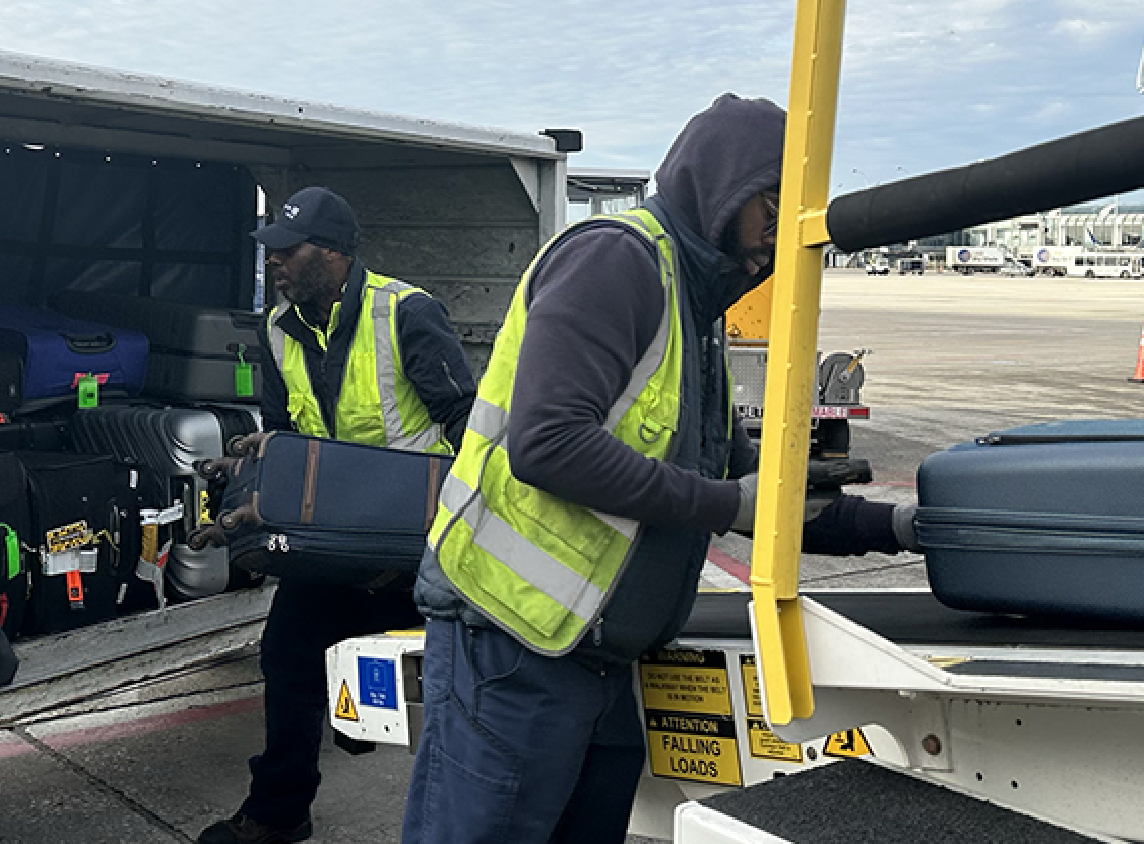
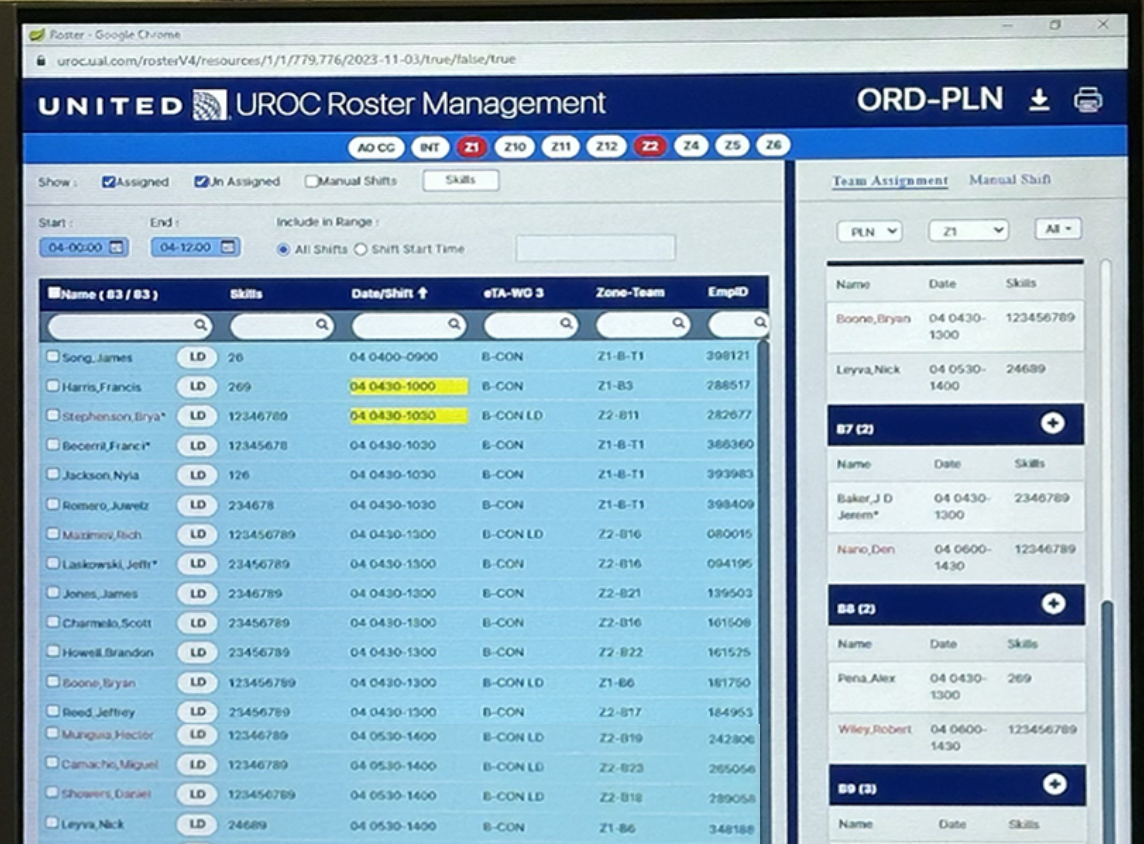
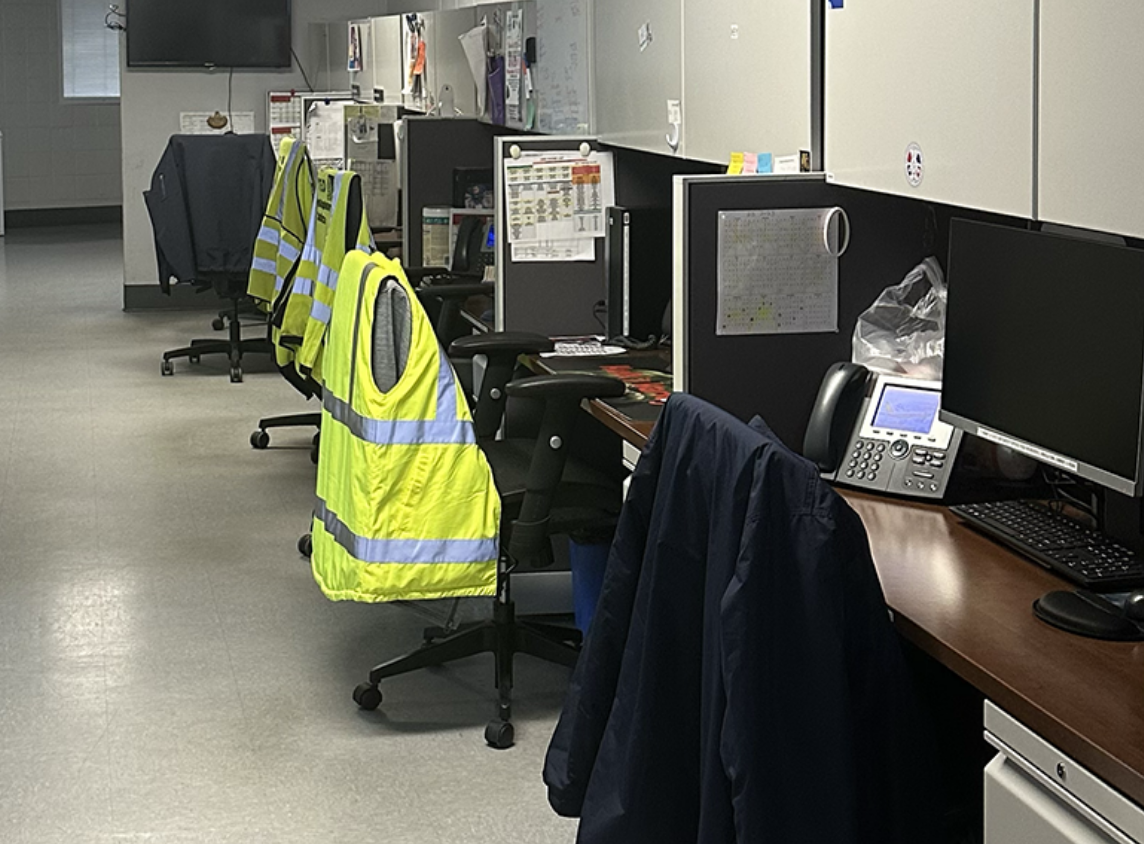
Complexity of Fatigue
Efficiency of U-ROC
Communication Challenges
Fatigue is multifaceted, and elusive, originating from various sources and
capable of manifesting in numerous ways. So there is NO sufficient data on fatigue.
The current scheduling system leans
heavily towards operational efficiency while sacrificing some focus on the teaming, culture and employee-centric aspects of the job.
Dissonant team dynamics and communication challenges make it difficult for ramp workers to receive essential support, leading to fatigue and injuries.
GOAL
Empower United Airlines and its employees to actively tackle fatigue and associated injuries, balancing employee wellness and operational safety through a comprehensive solution from both management and frontline perspectives.
SOLUTION
Developing a Human x AI collaborative system for a streamlined fatigue-injury feedback loop, allowing ramp workers and the UA safety team to proactively manage fatigue, ensuring timely interventions and adjustments.
* Peer Robot’s Ecosystem :
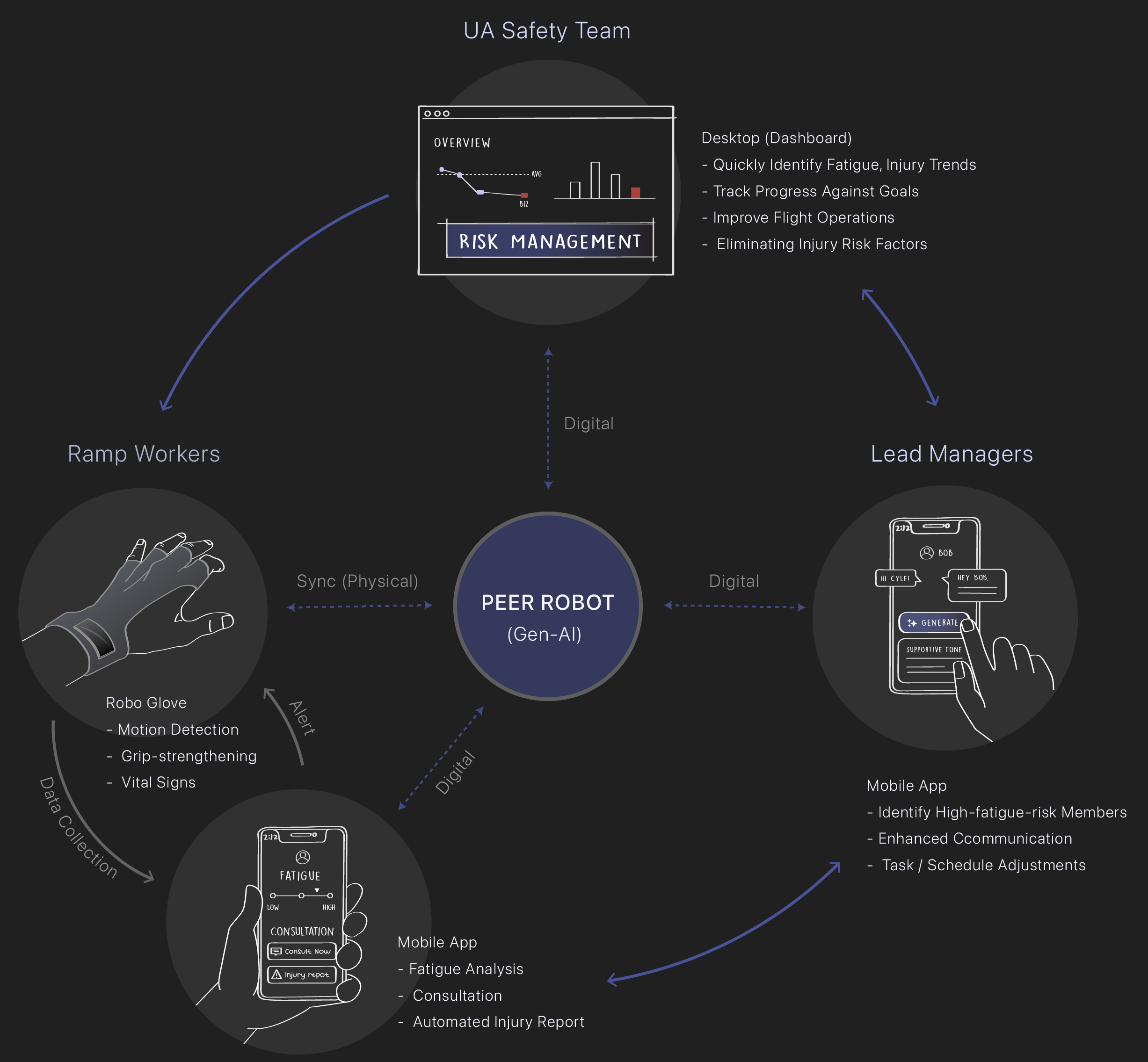
* Digital Side Details (Core user benefits to solution) :
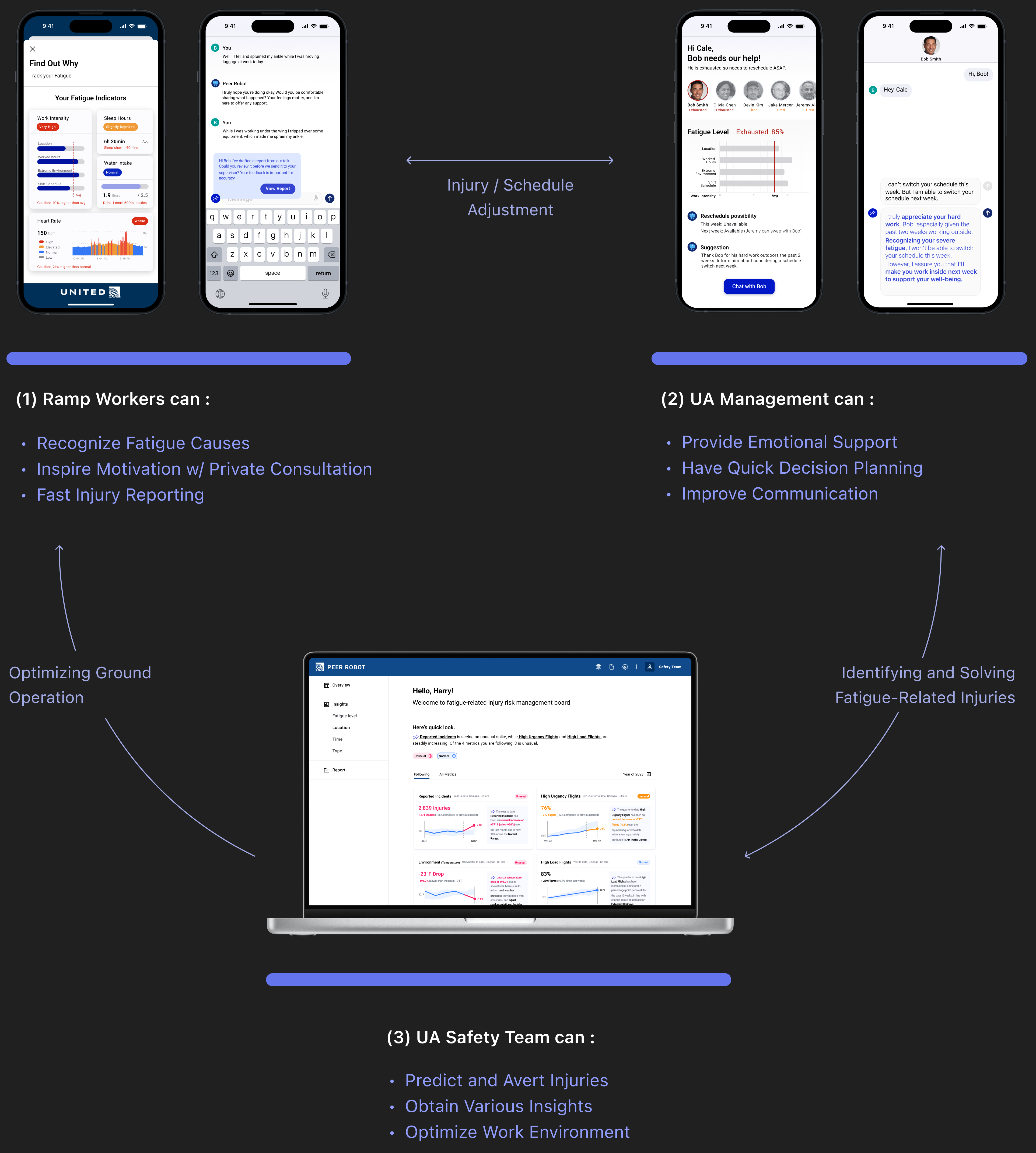
1. United Airlines Peer Robot App Design
The Peer Robot app lets ramp workers check fatigue levels, consult with Peer Robot, and file injury reports, which are sent directly to the UA managers and safety team. Also, contextual chatbot helps managers to transform their communication style towards being more empathetic and friendly, preventing the conflicts and emotional exhaustion.
Peer Robot acts seamlessly as a layer, like technological peers.
[ Use Case 1 – Manager Side ]
Gen AI collaborative conversation with users
Affable AI chat assistant to build rapport within the team.
Peer Robot enhancing managerial efficiency in fatigue monitoring and positive language transformation for rescheduling procedures.
[ Use Case 2 – Ramp Worker Side ]
Supportive insights + conversation with Gen AI
Private, supportive consultant to reduce individual frustrations.
Peer Robot monitors fatigue with integrated devices for injury prevention and offers private stress management consultations for stress management related to repetitive tasks assigned by leadership.
[ Use Case 3 –Ramp Worker Side ]
Supportive conversation with Gen AI
Worker-friendly automated injury report to improve safety.
Peer Robot contributes to collecting accurate injury-related data by economizing the report process to allow ramp workers easy access, which prevents ongoing injury occurrences and missing data.
2. United Airlines Safety Team Dashboard Design
Peer Robot supports the UA safety team in refining safety protocols, analyzing injury and fatigue data for improvements, and using advanced analytics to tackle Ramp Workers' challenges, ultimately fostering a safer, more positive workplace
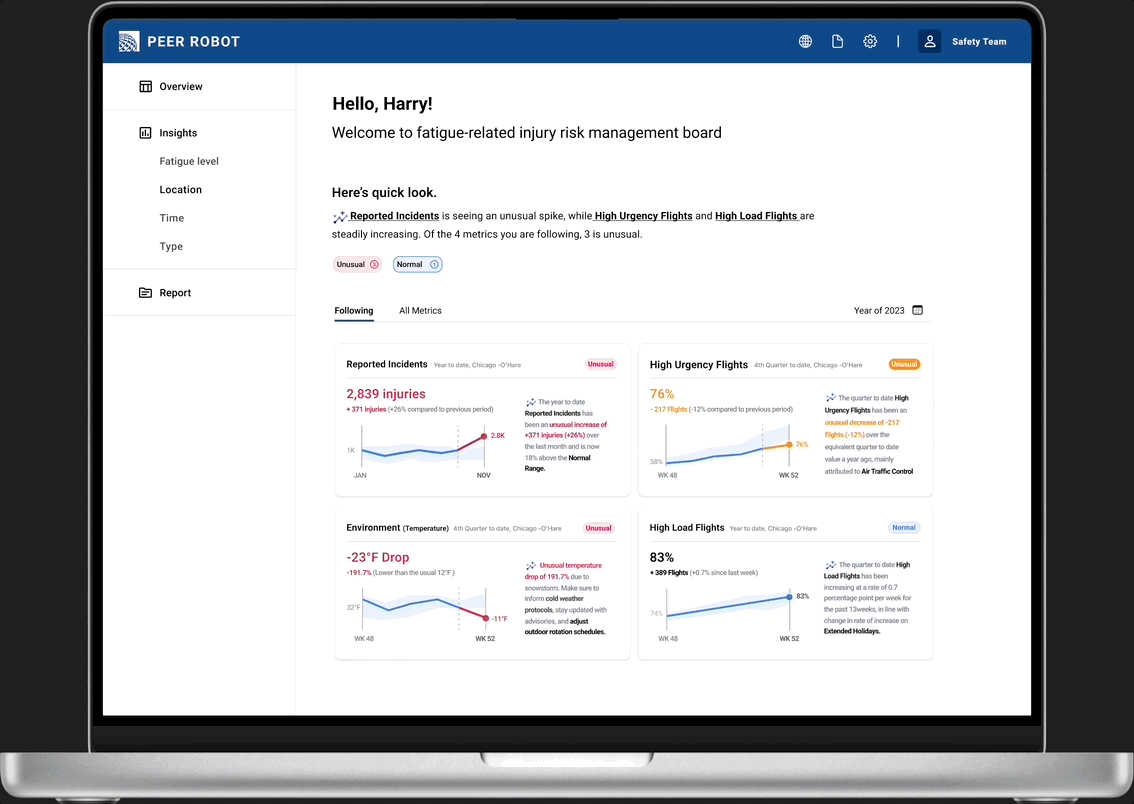
[ Use Case 4 – Safety Team Side ]
Gen AI supportive insights for UA safety
Insight analysis of injury causes, allowing for prevention risk.
United Airlines' Safety Team can get a report to pinpoint the causes of injuries and implement preventive measures.
Employees receive optimized safety recommendations based on injury data, weather, fatigue levels, and more.
They can view monthly injury data categorized by fatigue level, injury type, and location.
* The mobile app and dashboard achieved SUS Score 87
"Nice and well-rounded work from start to finish, skillfully integrating technology with a keen focus on user needs which we don't have right now. This helps in enhancing our operational understanding and efficiency."
– Antwon Warden, Operations Safety Manager –
[ From Prioritizing Efficiency to Safety ]
Peer Robot can be an important part of constant safety improvement that can significantly contribute to UA’s target of 25% reduction injuries over the next few years, 1% reduction in both OSHA recordable injury and Lost Time Injury rates.
* Annually, around 243,000 people globally are injured in ground operations incidents. Ramp accidents cost major airlines worldwide at least US$10 billion a year.
UNDERSTAND AIRLINE OPERATIONS
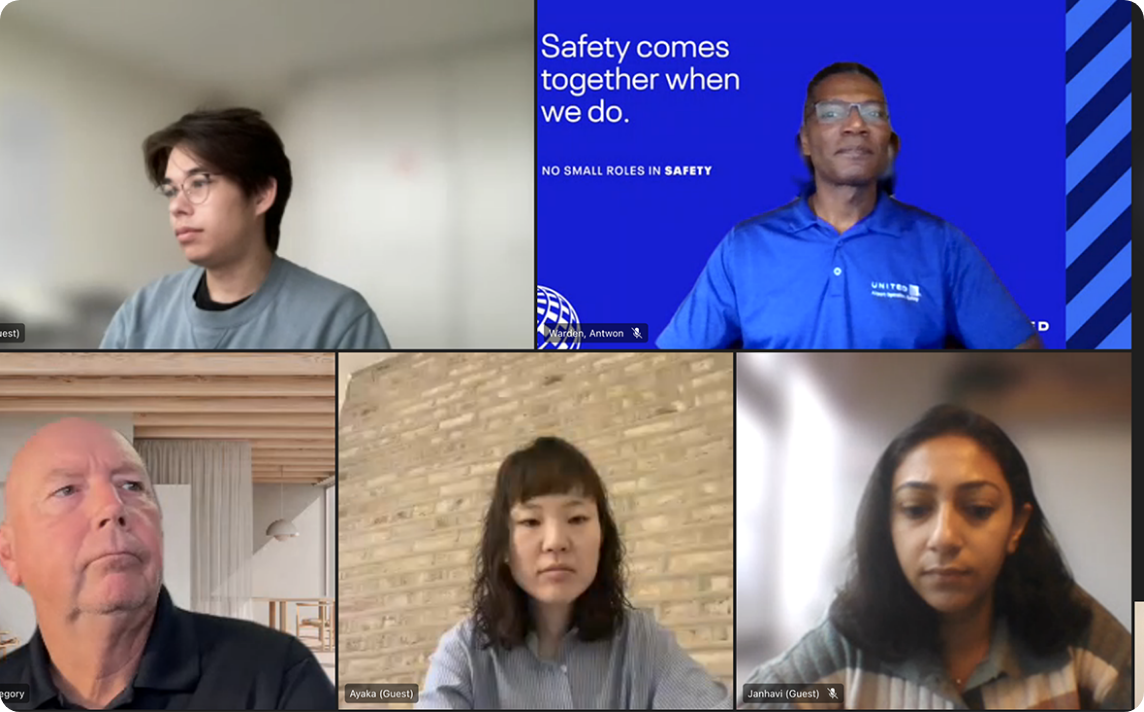
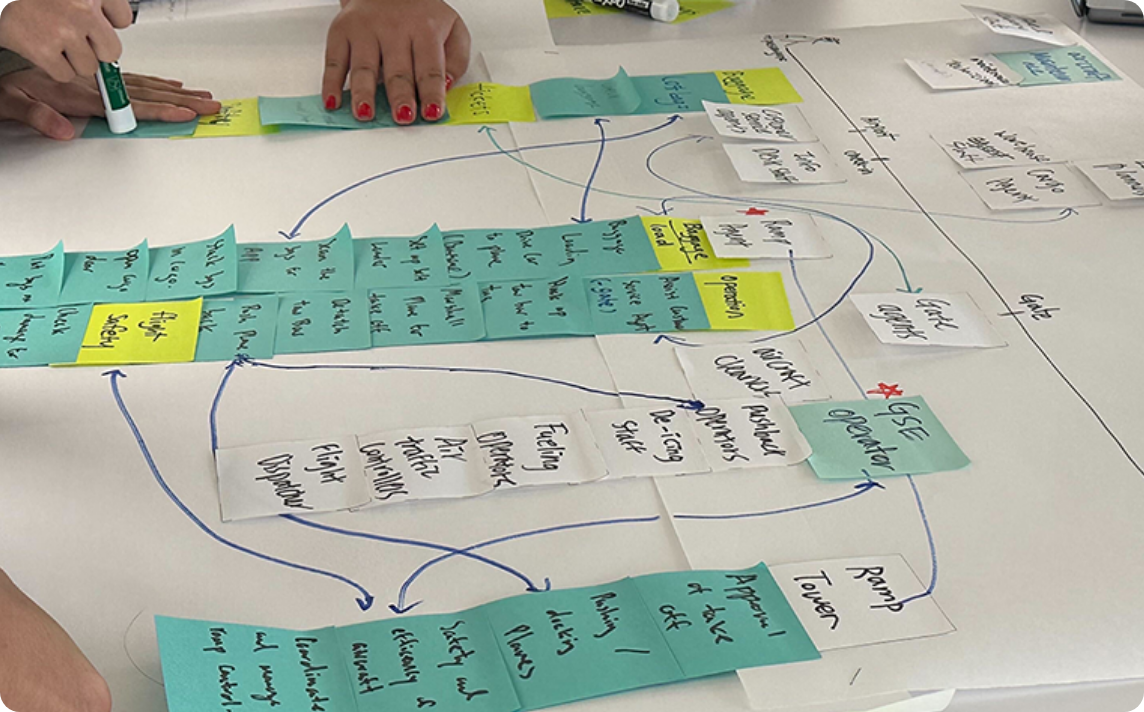
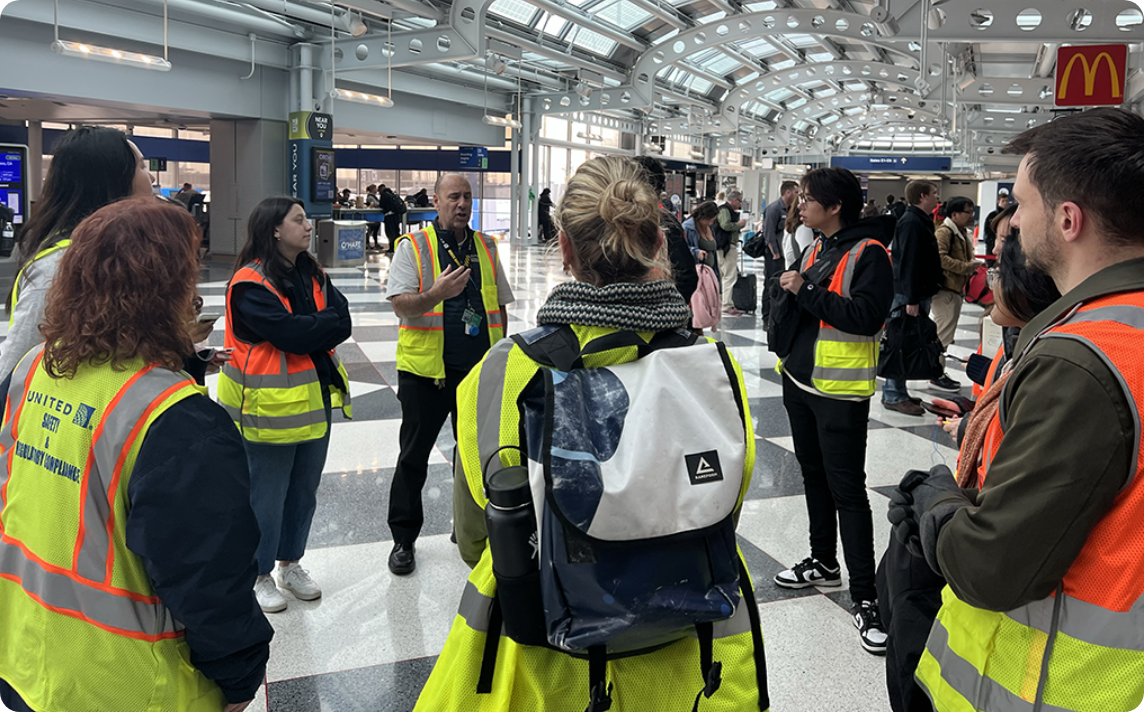
Regular Meetings w/ Safety Team
Organization Study
4 Ramp Worker Interviews
Scope of Safety Ops
UA’s Flight Operation Flow
Site Observations
General processes, pain points, partners, and constraints in ops.
Mission, current technology-in-use, challenges, and touch points in ops.
Understanding ramp workers’ archetypes, behaviors, and envt.
UNDERSTAND 'FATIGUE'
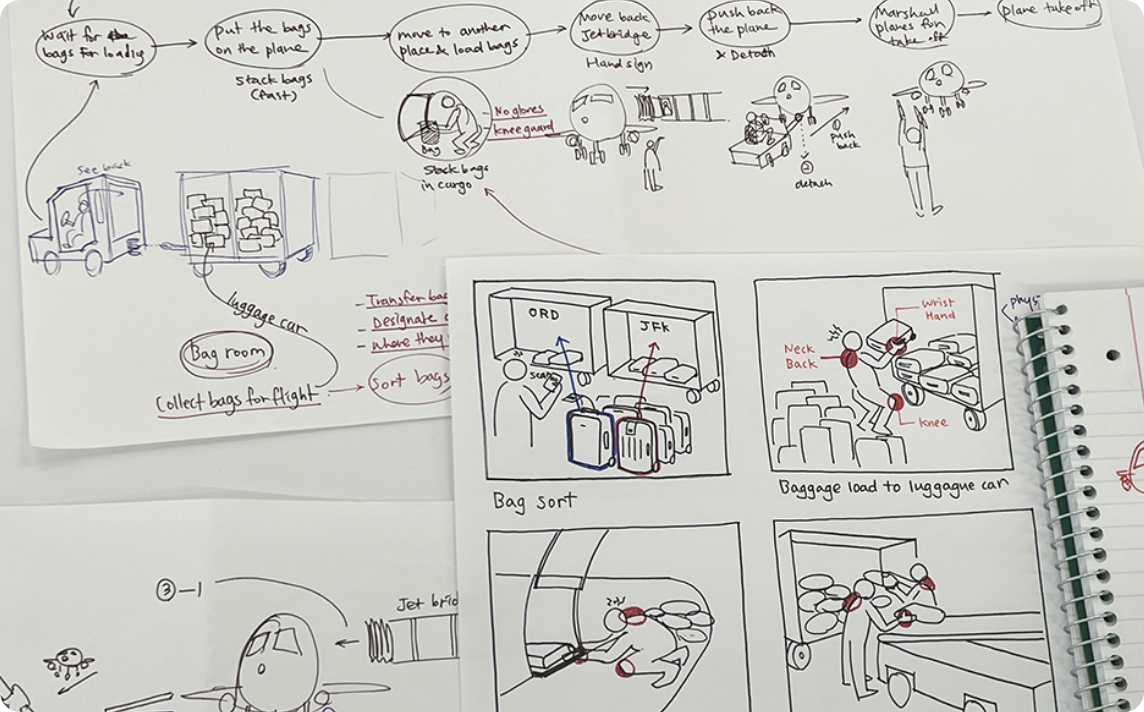
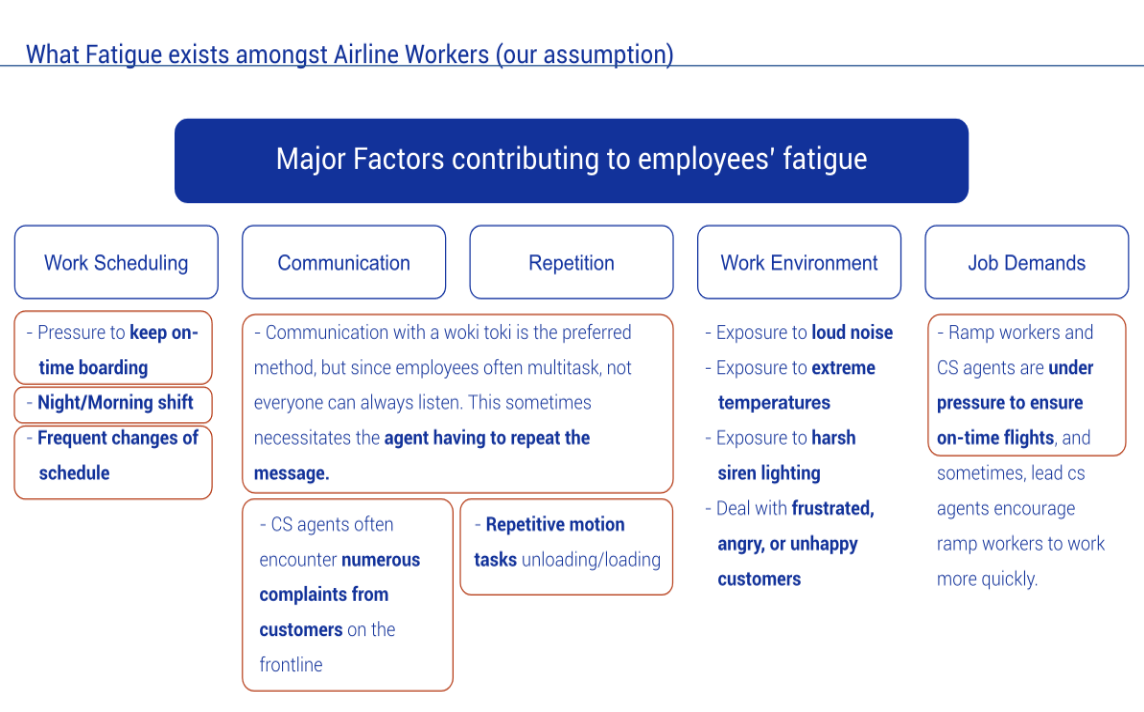
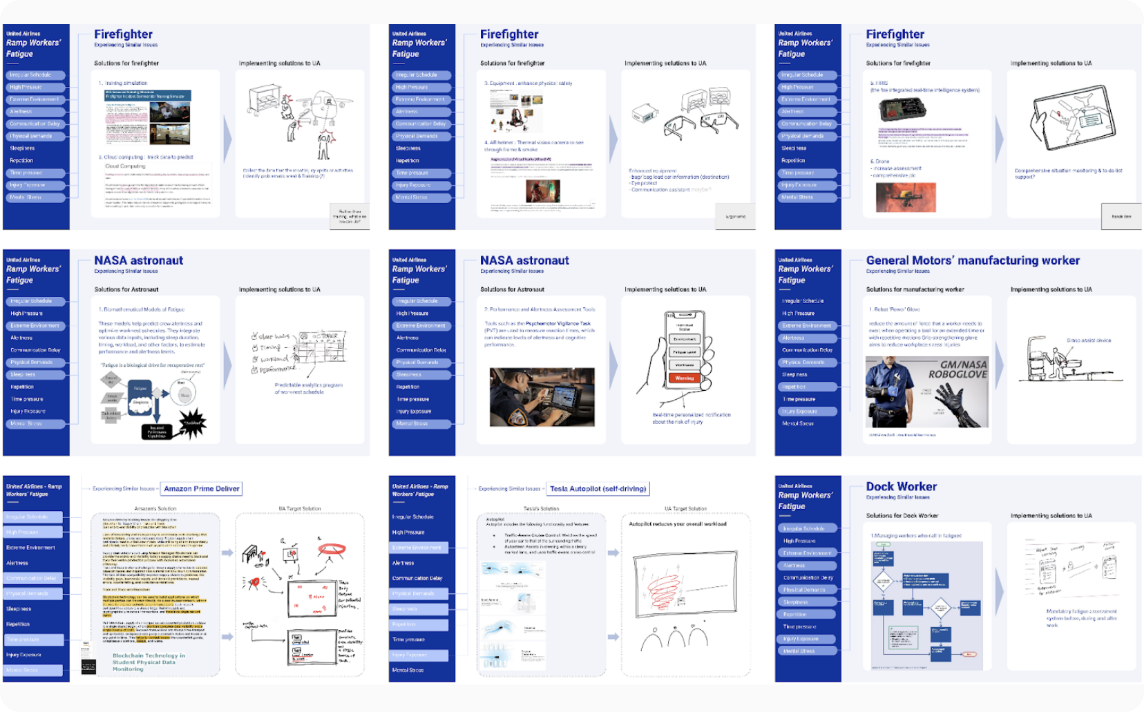
A day on the job
20+ Literature Review
20+ Case Studies
Investigating key moments of fatigue in ramp agent’s routine
In-depth examination of major factors influencing fatigue
Analogical Reasoning : Cross-industry solution analysis
Capture challenging workload leading to hight levels of fatigue.
Develop fatigue index for objective data collection with key factors.
Fatigue management in logistics, retail, healthcare, government offices.
FATIGUE IS COMMON among airline workers due to :
Physical Repetition w/ Communication Strain
On-time Boarding Pressure
Long and Irregular Working Schedule
Exposure to Extreme Work Environment
PROBLEM STATEMENT
it is difficult for ramp workers to receive the essential support, leading to fatigue and injuries due to lack of fatigue-specific data, difficulty for ramp workers to report fatigue, complexity of United Airlines’ injury reporting system, and seniority affecting unfairness in team dynamics and communication.
" HMW implement personalized supportive system that effectively reduce fatigue, significantly improving the working conditions and safety of ramp workers "
WHY HUMAN + AI PARTNERSHIP (Benefits from Gen-AI Tech)
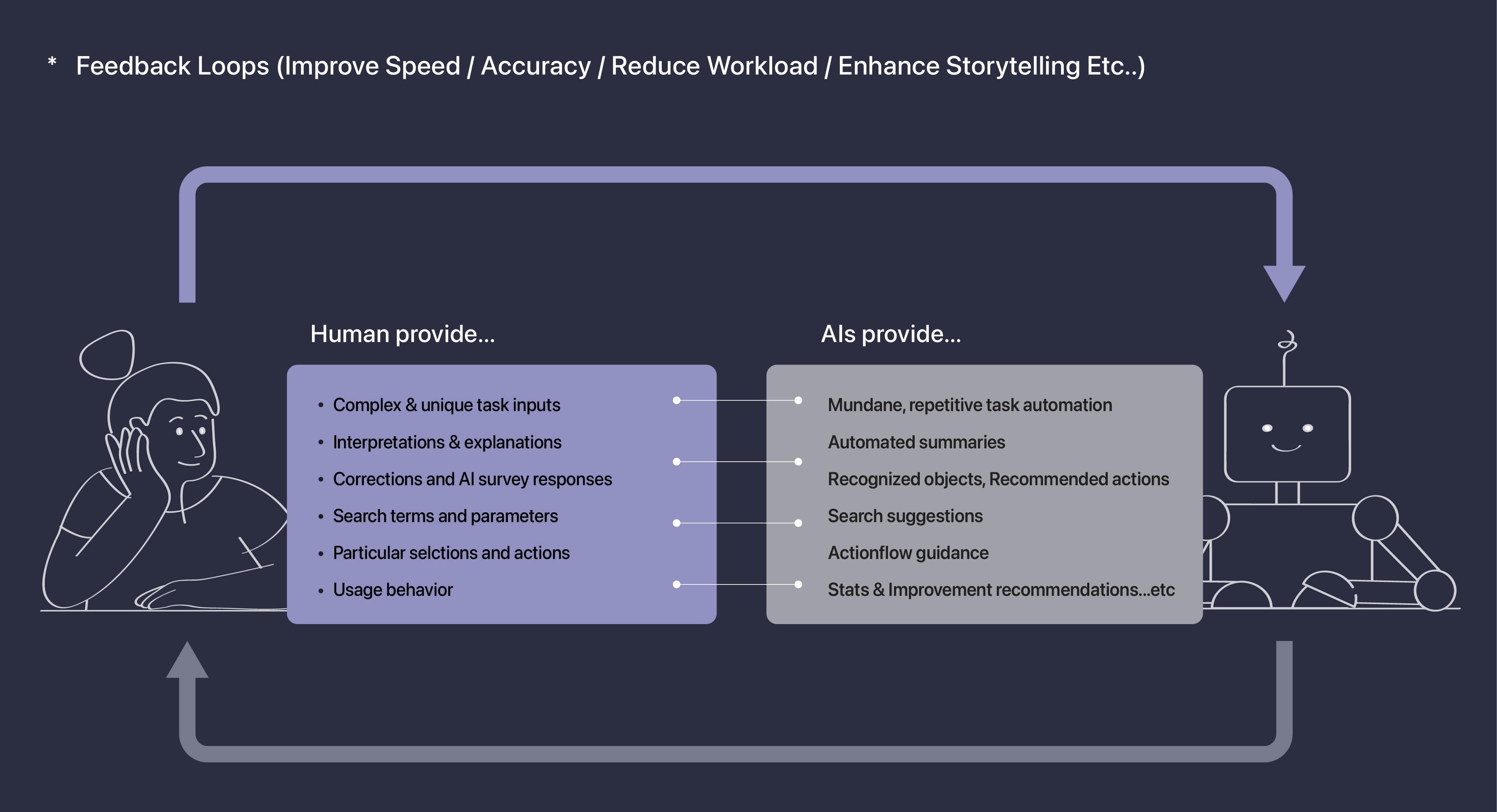
AI-DRIVEN 3 KEY FEATURES of PRODUCT
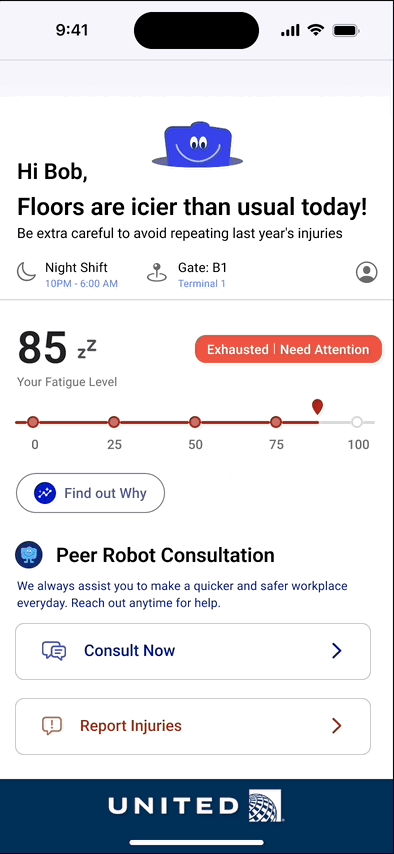
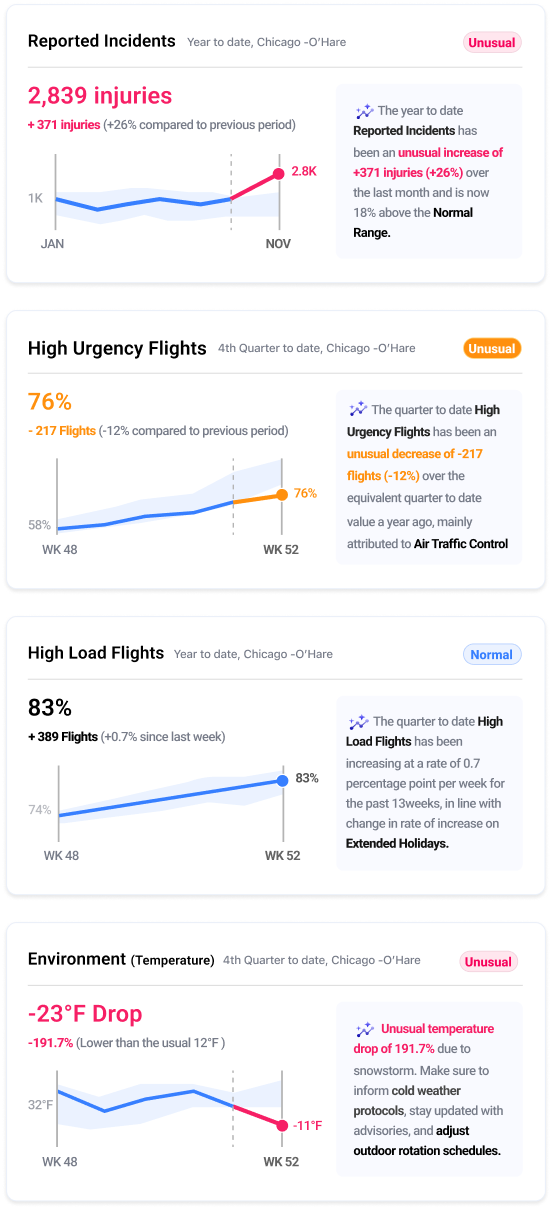
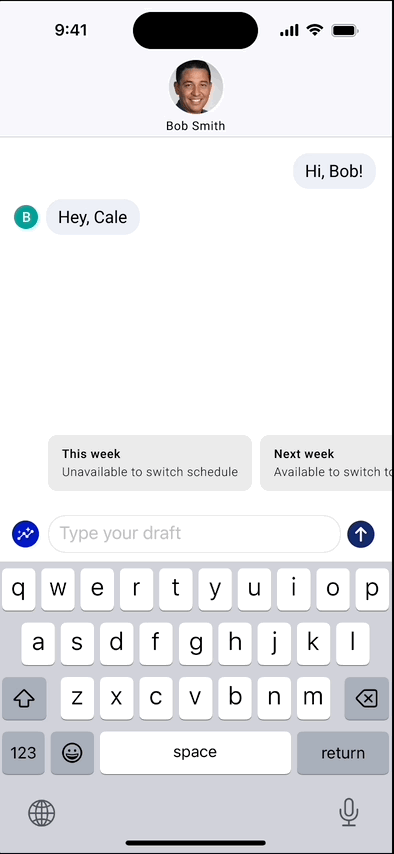
Empathetic Tone Adjustment
Real-time Personalized Support
Comprehensive Trends Analytics
- Empathetic Dialogue
- Relationship Enhancement
- Adaptive Workforce Scheduling
- Informed Fatigue Insights
- Customized Consultation of Work
- Efficient, AI-facilitated Reporting
- Fatigue/ Injury trends Identification
- Data-Driven Decision Making
- Actionable Recommendations
DESIGN PRINCIPLES
#1 User-Centric Adaptability : Ensuring the AI system is flexible and responsive to the different user context
#2 Privacy and Security : Avoid Peer Robot sending worker’s personal data without their consent.
#3 Simplicity in Analytic Insights : Minimizing the cognitive burden of understanding analytics.
#4 Empathetic Interaction : Embed conversational AI interactions on a human level.
STRATEGY AFFINITY & CONCEPT COMBINATION
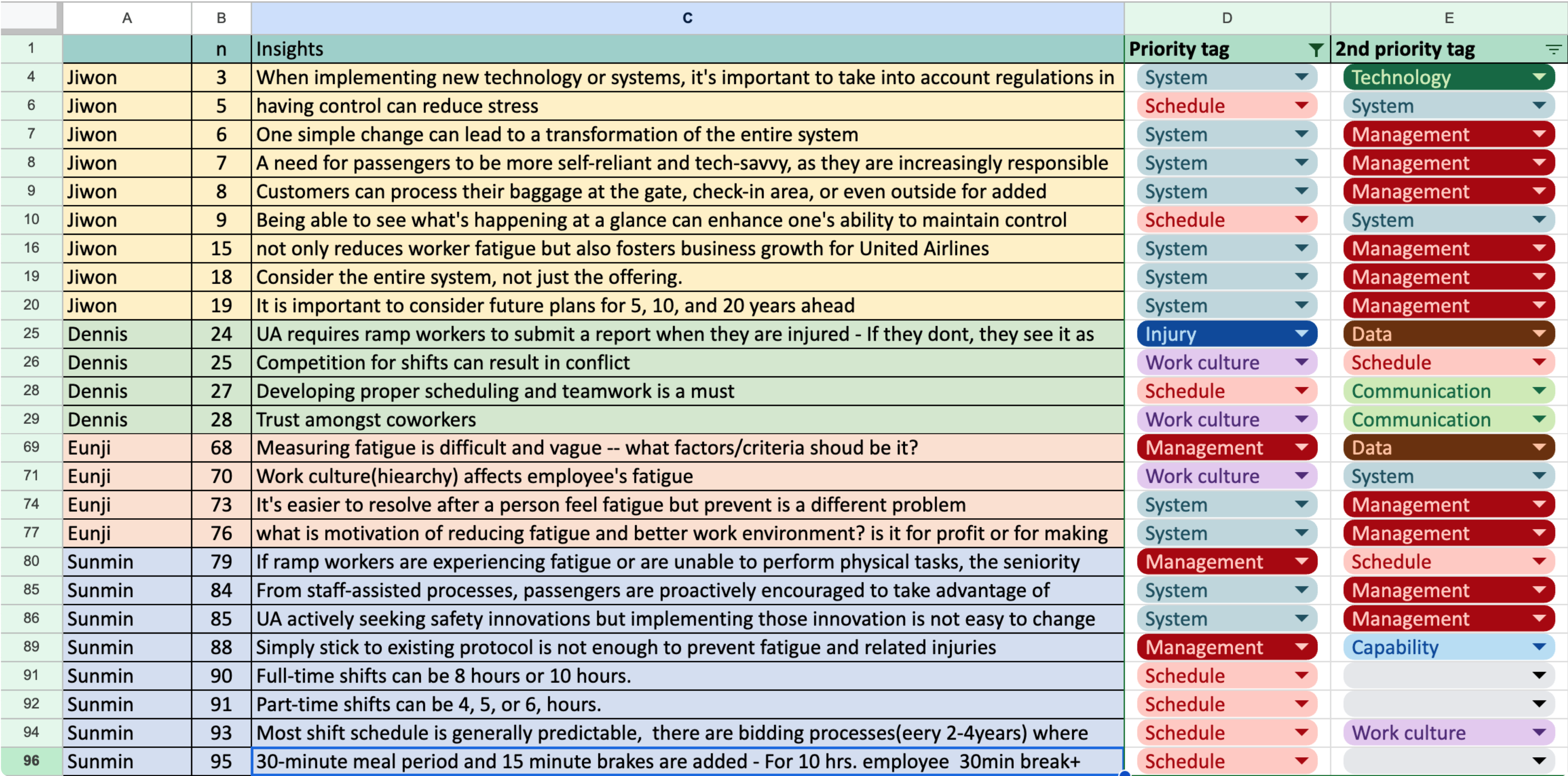
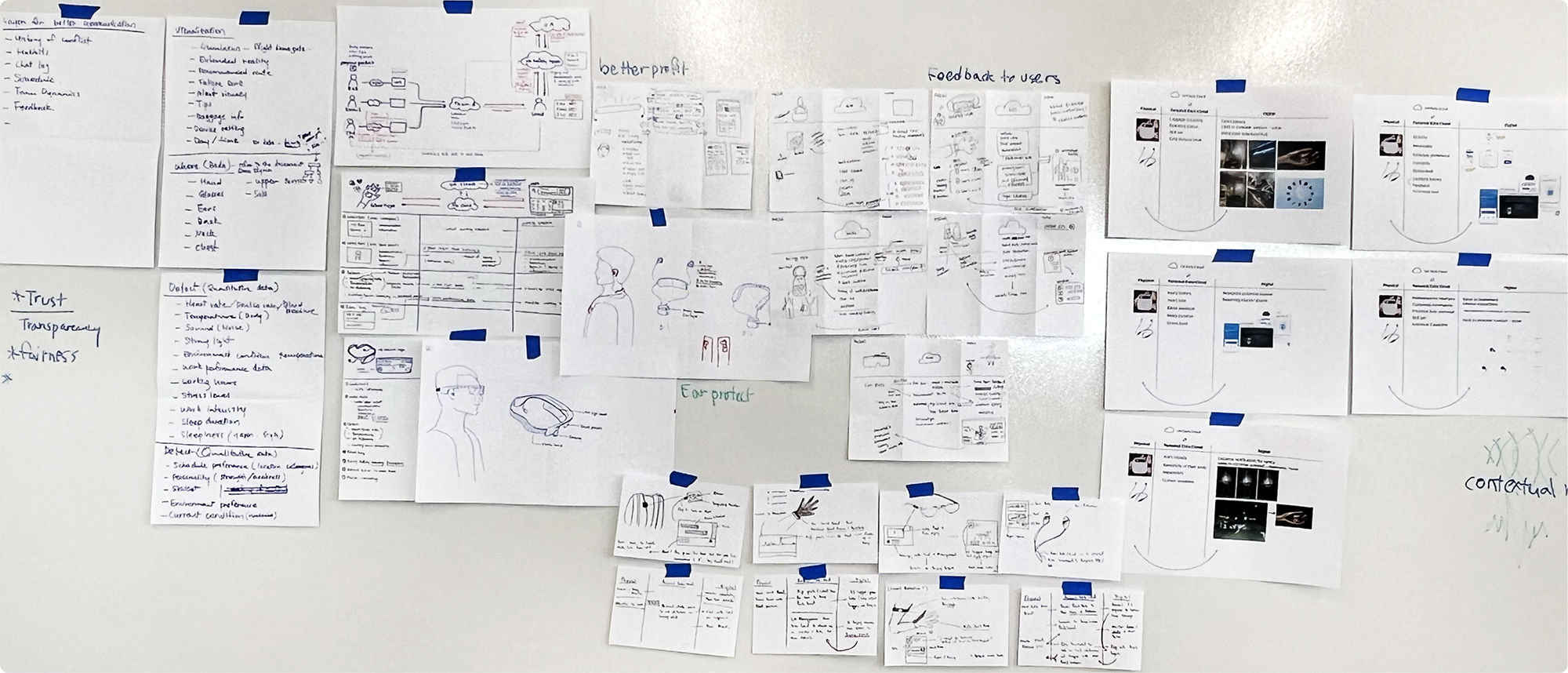
Generated and structured concepts in features, functions, and ideas.
This process led us to conceptualize of systems, offerings, and platforms that not only address the identified challenges but also expand the power of collaboration and innovation to create more impactful changes.
DEVELOP FATIGUE INDEX
Fatigue index enables United to be aware of instances when employees are facing fatigue and make adjustment on the go.
SCENARIO + SERVICE BLUE PRINT (Multi-tiered strategy)
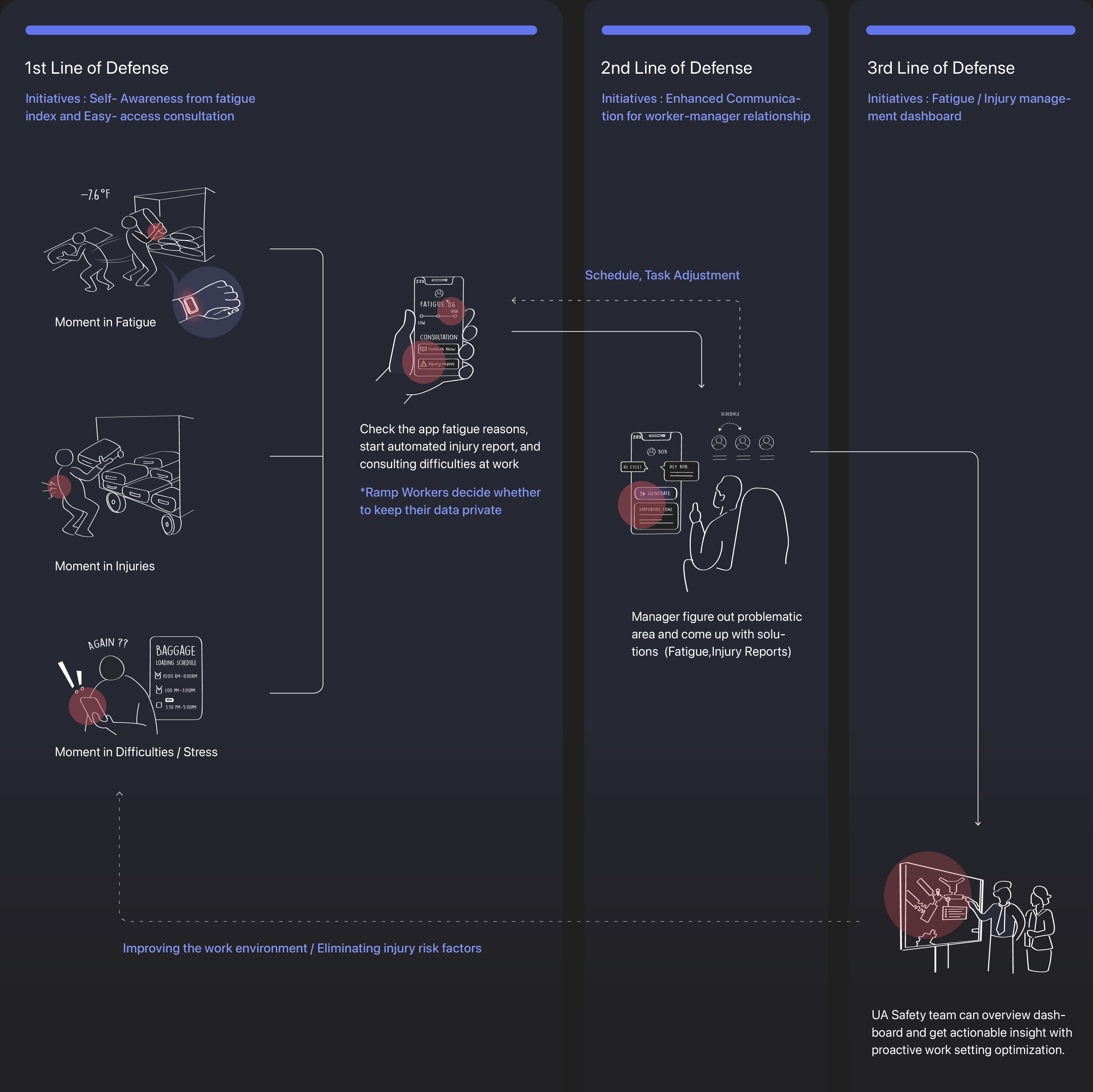
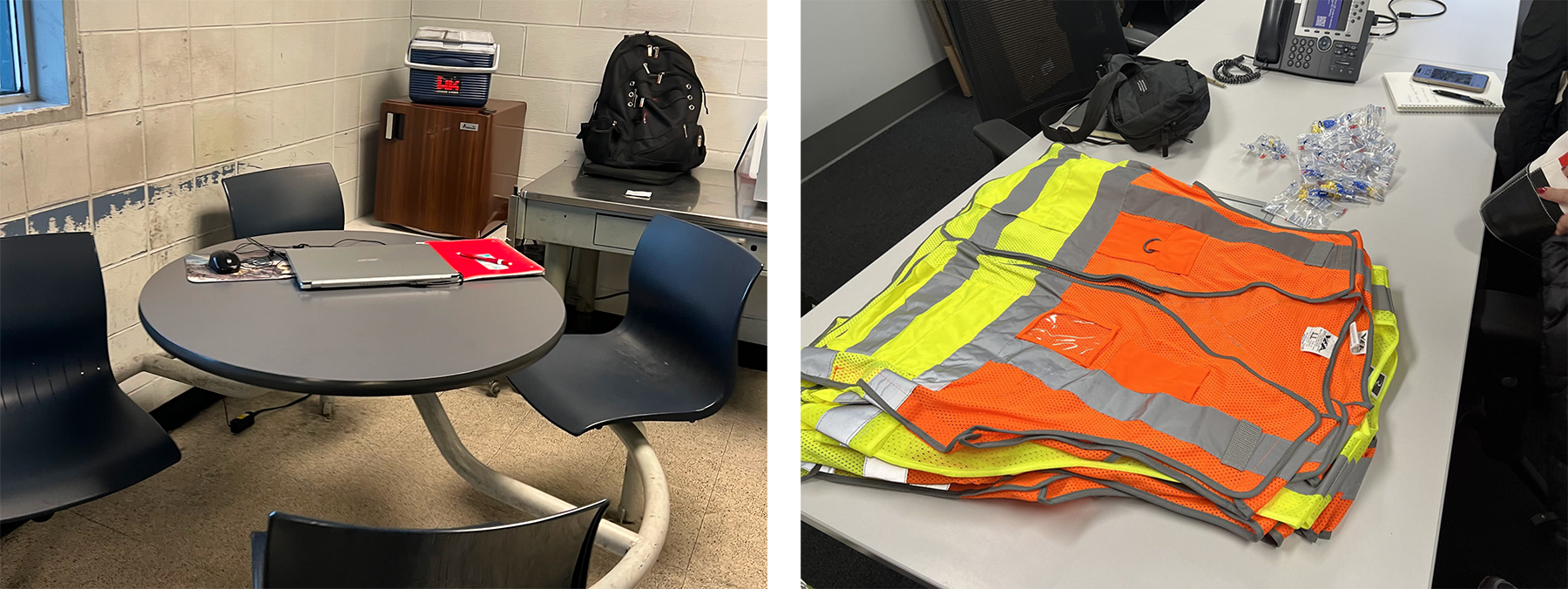
⌘ For the confidentiality reasons, testing images are not shown.
Main Insights
01. Workers felt anxious about privacy, fearing their consultations might be monitored or judged.
- When showcasing our prototype, ramp workers shared a desire for private conversations with Peer Robot.
02. Ramp workers found the new injury reporting process helpful.
- Ramp workers expressed the need to edit injury reports before submission.
03. Adjusting the amount of information was important to reduce the cognitive load.
- Users noted that the fatigue tracker section in the prototype was information-heavy, making it difficult to digest.
- The prototype was challenging to navigate, highlighting the need for improved navigation.
[ DESIGN ITERATION 1 of 3 ]
Develop quantifiable measures for the subjective concept of 'Fatigue', shifting from a cluttered, inaccurate feature set to streamlined one.
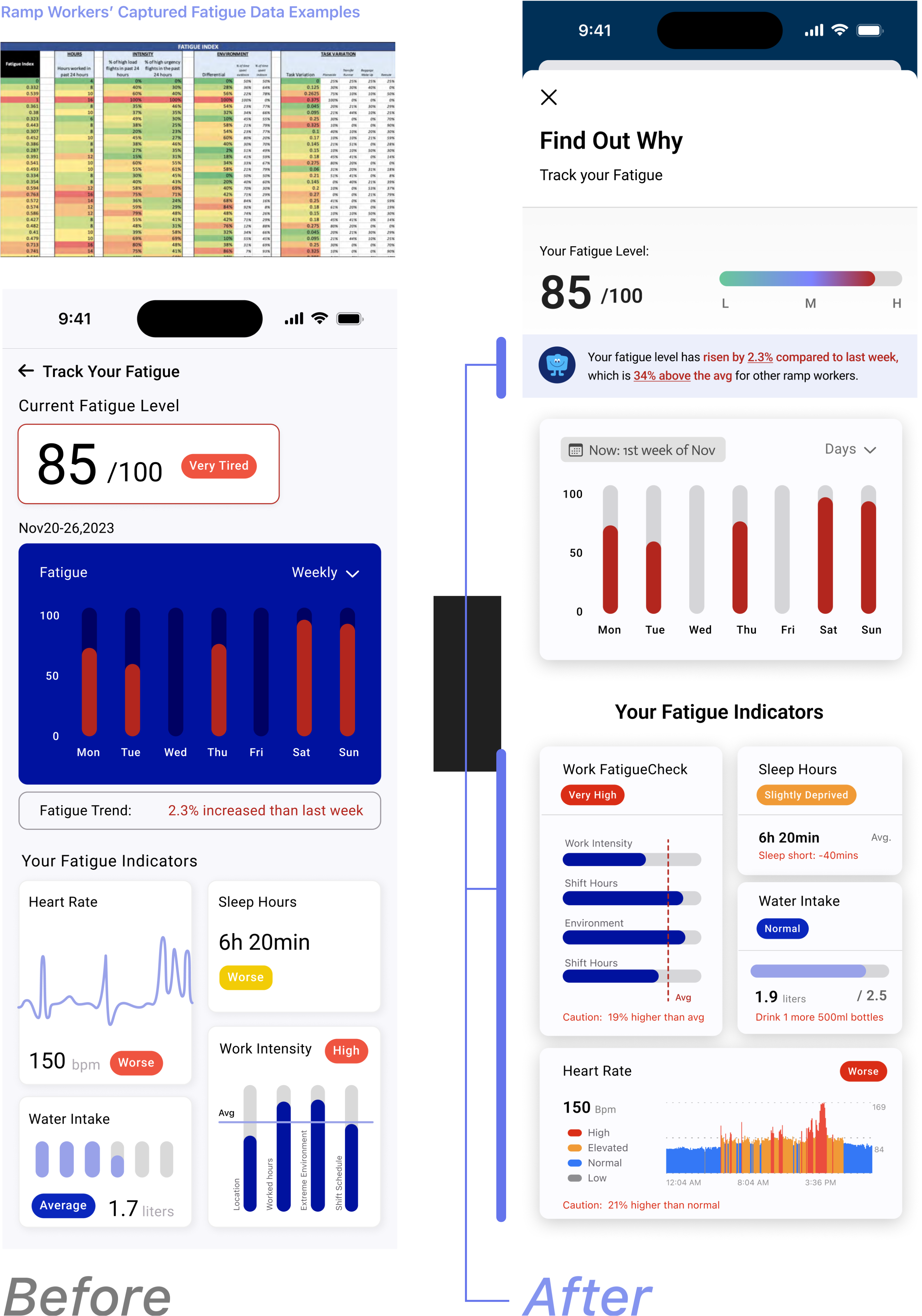
Cluttered interface tracking numerous fatigue-causes. Users stated this seemed disorganized and don’t know what to check first.
Simplify access to personalized insights and set a reference point to help users gauge their progress in reducing fatigue.

[ DESIGN ITERATION 2 of 3 ]
Provide user focused options to ramp workers for keeping chats with Peer Robot private or sharing it with UA, enhancing user trust and engagement.

�Doubts emerged among users about their trust in and continued use of the system. They wanted to ensure their dialogue with peer robots was secured.
Enhance user trust and autonomy by offering choices in managing personal data privacy in technology interactions.
DESIGN ITERATION 3 of 3
Implement fatigue-injury insight cards at the forefront, clearly visualizing normal range and deviations or unusual trends into a simple graph.
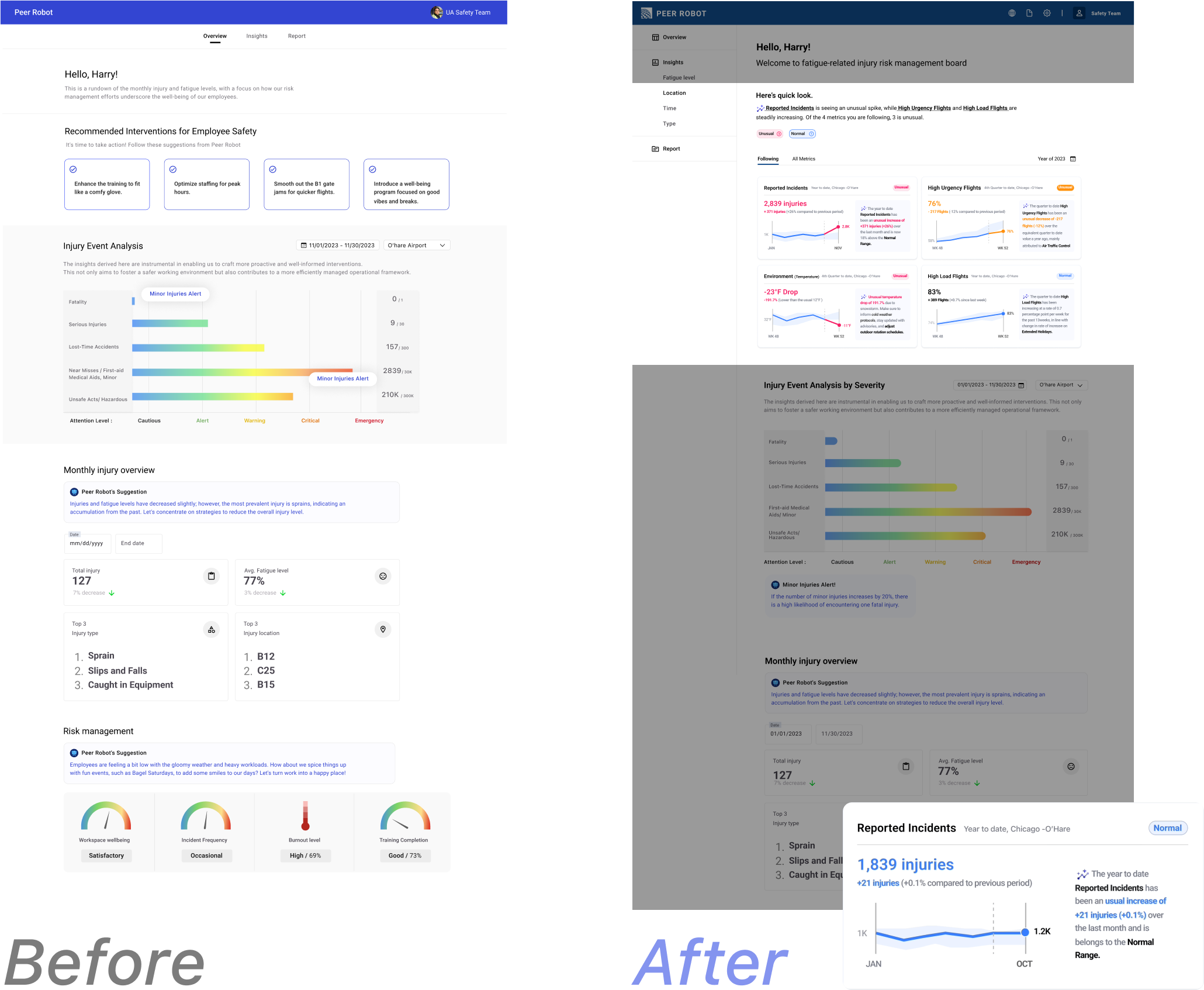
Difficult to find specific data, requiring users to navigate through multiple layers or screens.
User mentioned presented data was not easily interpretable, requiring extra effort to understand.
- Organize fatigue and injury insights into distinct tabs for emphasizing ease of navigation and accessibility.
- Improve data visualization allowing users to quickly identify deviations from normal patterns supported by data backups.
1. Becoming a more team-oriented designer and embracing differences as part of the process ; Design is team sport.
Reflecting on time with United Airlines, I realized that being a team-oriented designer and embracing differences were pivotal to our process. The design development journey was not just about crafting innovative solutions; it fundamentally involved shaping and nurturing our team culture. This understanding has fostered a more inclusive and dynamic team environment, where diverse ideas and perspectives are celebrated, leading to more innovative and effective solutions.
2. It is important to wear multiple hats ( the Researcher, PM, Visual deisnger, etc) as a strategic designer.
This versatility has not only enhanced my capacity to contribute across different stages of the design process but also deepened my understanding of the intricacies involved in bringing a project to fruition
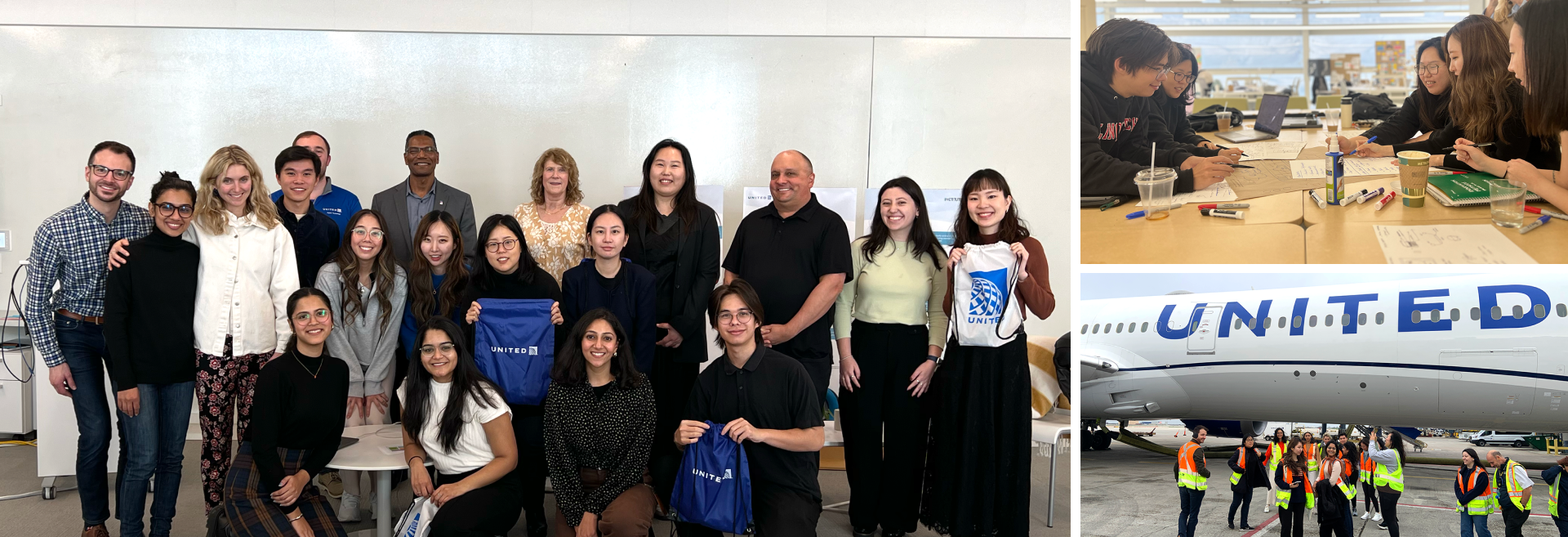
〈Next,
Steele, AI- supported workforce matching tool
Elevating team confidence and work performance for salespeople
by strategically matching the right fit specialists and resources.
〉 


































